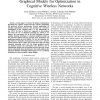Free Online Productivity Tools
i2Speak
i2Symbol
i2OCR
iTex2Img
iWeb2Print
iWeb2Shot
i2Type
iPdf2Split
iPdf2Merge
i2Bopomofo
i2Arabic
i2Style
i2Image
i2PDF
iLatex2Rtf
Sci2ools
GLOBECOM
2009
IEEE
2009
IEEE
Exploring Simulated Annealing and Graphical Models for Optimization in Cognitive Wireless Networks
In this paper we discuss the design of optimization algorithms for cognitive wireless networks (CWNs). Maximizing the perceived network performance towards applications by selecting appropriate protocols and carrying out cross-layer optimization on the resulting stack is a key functionality of any CWN. We take a "black box" approach to the problem and study the use of simulated annealing for solving it. To improve the convergence rate of the basic algorithm we apply machine learning techniques to construct graphical models on the perceived relations between network stack parameters and application-specific network utilities. We test our optimizer design both in a simulation environment as well as on a network testbed with low-power radios. Our results show that even basic simulated annealing works well, but simple graphical models can further increase the convergence rate. However, use of sophisticated models such as Bayesian networks does not always lead to substantially bet...
| Added | 16 Aug 2010 |
| Updated | 16 Aug 2010 |
| Type | Conference |
| Year | 2009 |
| Where | GLOBECOM |
| Authors | Elena Meshkova, Janne Riihijärvi, Andreas Achtzehn, Petri Mähönen |
Comments (0)

